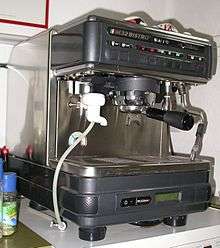Cimbali
|
| |
| Privately held company | |
| Industry | Specialty coffee brewing equipment |
| Founded | 1912 in Milan, Italy |
| Founder | Giuseppe Cimbali |
| Headquarters |
|
| Products |
Espresso machines Coffee grinders Accessories |
Number of employees | ~600 people (2007) |
| Website | Cimbali.com |

Cimbali (with brand name LaCimbali) is an Italian manufacturer of professional espresso and cappuccino equipment.[1]
Overview
Gruppo Cimbali SpA is based in Binasco, near Milan. It has four production facilities, all located in Italy, which cover a total area of 75,000 m² (800,000 ft²), of which 40,000 m² (430,000 ft²) indoors. With branch offices in France, Spain, the UK and in the United States, the company employs more than 600 people. Today, Cimbali exports roughly 70% of its production through a network of 700 direct sales and service centers to over a hundred countries around the world.[2]
Company history
Cimbali was established in 1912 by Giuseppe Cimbali in Milan, at Via Caminadella 6. Covering 30 m² to accommodate the owner and his two employees, the first shop ("Cimbali Giuseppe — Copper Plumbing & General Repairs") specialized in the manufacture of copper goods.
In the 1930s, coffee machines produced steam and hot water by burning wood or coal beneath a vertical boiler. They were cylindrical in shape and were therefore called column machines. Cimbali’s first column machine was called the “Rapida”.
The positive post-war atmosphere in Italy brought an increase in the consumption of coffee, thus further driving the development of the company's operations. As a result, the market demanded machines with enhanced productivity. In 1945, Cimbali’s “Albadoro” model featured two independent vertical boilers. Modular in design, the “Albadoro“ was made available in 3 to 6 brew groups. The “Albadoro” was the first machine to feature an integrated cup warmer.
In the late 1940s and early 1950s, boilers powered by electric heating elements began to replace wood and coal heated boilers. Moreover, it was during this period that lever machines radically changed the way of extracting coffee. This new technique forced water through coffee at a pressure of 9 atmospheres, thus obtaining a high-efficiency extraction of the aroma, and ultimately the crema caffè.
In 1955, the company introduced the “Granluce”, the first coffee machine to feature a hydraulic group. Patented by Cimbali in 1956, the hydraulic group signaled a transformation within the professional espresso machine industry. The new hydraulic group and its dosed delivery represented the first important step towards automation. 1959 saw the arrival of a model with the application of a heat exchanger, which was later to become an essential constructional element, ensuring the thermal balance of the machine.
In 1962, with the cooperation of the famous Italian designers, Castiglioni, Cimbali created a product of extraordinary modern design: the “Pitagora”. The “Pitagora” abandoned the redundant shapes typical of the machines of the period and adopted essential, clean lines. Stainless steel was used for the first time, along with color and screen printing. The result was revolutionary, gaining Cimbali a prestigious industrial design award, the Compasso d’Oro.
Designed in 1969 for the foodservice industry, Cimbali’s “Superbar” was cutting edge for completely automated solutions.
At the beginning of the 1970s, product design became characterized by an approach which was more closely linked to an industrial process. The body of the M15, designed by Bonetto, was made of only 6 main structural elements. Alongside the hydraulic and lever groups there was also a direct injection group equipped with an external pump.
In the 1990s, Cimbali integrated a microprocessor to the “Dosatron” in order to better govern the main functions of the machine.
In 1992, Cimbali introduced the “Dolcevita”, a family of fully automatic espresso machines targeting in-cup consistency and beverage quality. Designed by Salvemini, the “Dolcevita” played a significant role in Cimbali’s growth outside Italy in non-conventional markets new to espresso coffee.
In 1995, Cimbali purchased its leading Italian competitor, Faema.
Certifications and social responsibility
Cimbali has certified its factory production processes according to ISO 9001 standards. Its products are accredited by major international organizations including TUV and UL. Furthermore they comply with the most rigorous international hygiene and sanitation authorities including NSF and ETL. The Cimbali product range is RoHS compliant. Moreover, the company is in process of certifying its environmental management system to ISO 14001 standards.
See also
References
- ↑ Gruppo Cimbali SpA, August 26, 2008.
- ↑ Gruppo Cimbali S.P.A.. Food and Hotel Asia. Accessed April 29, 2012.